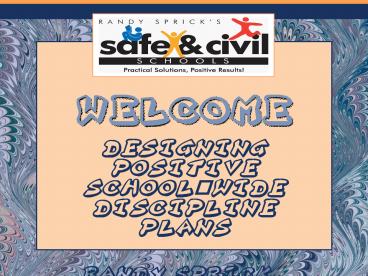Designing Positive School-Wide Discipline Plans Randy Sprick, Ph.D. - PowerPoint PPT Presentation
1 / 37
Title:
Designing Positive School-Wide Discipline Plans Randy Sprick, Ph.D.
Description:
Designing Positive School-Wide Discipline Plans Randy Sprick, Ph.D. Goal: To create a safe, civil and productive school. Foundations CHAMPs Interventions Which ... – PowerPoint PPT presentation
Number of Views:228
Avg rating:3.0/5.0
Title: Designing Positive School-Wide Discipline Plans Randy Sprick, Ph.D.
1
Designing Positive School-Wide Discipline
PlansRandy Sprick, Ph.D.
2
Goal
- To create a safe, civil and productive school.
3
- Foundations
- CHAMPs
- Interventions
4
- Which prom are you going to?
- From the Dallas Morning News
- April, 2004
5
The most popular question at _____High School
this month wont be Who are taking to the prom?
or What are you wearing? The most pressing
question will be, Which prom are you going to?
6
Irked by a school rule that bars many of their
classmates from the school-sponsored prom, a
group of students is planning an alternative prom
to compete with the official prom on April 24th.
7
High school principal Buddy ____, to encourage
classroom attendance, decreed that students who
collected eight absences between November 10 and
March 31, excused or not , cant attend the prom.
8
That didnt sit well with seniors Ian ___ and
Peter ____, who launched the alternative prom
idea with the help of friends.
9
It was a joke at first, said Ian, 17.
- Then we just said, Lets do it. They cant stop
us, added Peter, 18, - Were teenagers with time.
10
Graduation Rates?
- 2000-2003?
- 1946?
- 1900?
11
Graduation Rates??
12
District
13
Variables
- There are five variables that staff can
manipulate to increase the chances that students
will behave in a safe and civil manner.
14
- Structure/organize all school settings for
success. - Teach students how to behave responsibly in those
settings. - Observe student behavior (supervise!).
- Interact positively with students.
- Correct calmly, consistently and immediately in
the setting in which the infraction occurred.
15
STOIC One who is admired for patience and
endurance in the face of adversity.
16
Many schools depend too much on punitive
consequences
- Punitive consequences have inherent and
inescapable drawbacks including, but not limited
to - escape/avoidance
- fear
- may become neutral
- may become reinforcing
- can set a negative climate
17
(No Transcript)
18
(No Transcript)
19
District
School-Wide
Classroom
Ind. Student
20
The Improvement Cycle
Surveys Observations Disc. Referral Injury
reports Focus groups
Review
Prioritize
Implement
Revise
Adopt
21
Surveys
- Middle School Student Survey Responses Agree
22
Disciplinary Referrals
- Trends and patterns
- Type of offense
- Location
- Month or week
- Day of the week
- Time of the day
- Referring staff
23
Structure/organize all school settings for
success. For example
1
- Physical arrangements/org
24
Structure/organize all school settings for
success. For example Ending Routines
1
25
Structure organize all school settings for
success. For example
1
- Physical arrangements
- Scheduling issues
- Organizational patterns
- Routines and procedures
- Expectations for students
- Expectations for staff
26
Teach students how to behave responsibly in those
settings. For example
2
- Lessons on classroom expectations, routines and
policies - Lessons on common area expectations, routines and
policies - Lessons on essential behaviors such as respect,
bullying prevention, school pride, and possibly
even keeping things neat
27
For example Restrooms
2
28
Teach students how to behave responsibly in those
settings. For example
2
- Lessons on classroom expectations, routines and
policies - Lessons on common area expectations, routines and
policies - Lessons on essential behaviors such as respect,
bullying prevention, school pride, and possibly
even keeping things neat
29
Teach students how to behave responsibly in those
settings. For example
2
- Lessons on classroom expectations, routines and
policies - Lessons on common area expectations, routines and
policies - Lessons on essential behaviors such as respect,
bullying prevention, school pride, and possibly
even keeping things neat - Coaching provides a great model of teaching, and
reteaching as needed. - Coaching also provides a great model of
inspirational leadership.
30
Observe student behavior (supervise!).
3
- Without monitoring, even responsible adults will
push the limits. - In the classroom, this involves circulating and
scanning. - In the common areas, this involves organizing
supervision to insure that - a sufficient number of adults are present.
- friendly, respectful behavior is modeled.
- the adults are coordinating with and supporting
each other. - students receive consistent information on what
is acceptable and not acceptable.
31
Observe student behavior (supervise!)--Consistentl
y.
32
Interact positively with students. This involves
three different skills.
4
- A. Interact in a welcoming manner with every
student. - Say hello, use students names
- Show an interest in studentslisten, converse.
- B. Provide age appropriate, non-embarrassing
positive feedback.
33
Positively interact with students. This involves
three different skills.
4
- C. Strive to interact more frequently with every
student when s/he is engaged in positive behavior
than when s/he is engaged in negative behavior. - Some students are starved for attention.
- What you pay the most attention to is what will
occur more frequently in the future. - Strive for at least 31 positive to negative
ratios.
34
Correct irresponsible behavior calmly,
consistently and immediately in the setting in
which the infraction occurred.
5
- Some schools may implement a 3-Level System for
responding to misbehavior.
35
(No Transcript)
36
(No Transcript)
37
Fire in the Lab































